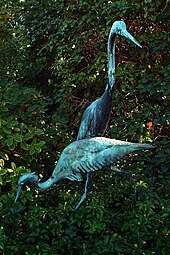Maschsee source

The so-called Maschseequelle in Hanover is a listed water pump and filter system on the west bank in the south of the Maschsee . The monument at Karl-Thiele-Weg 35 near the Leine is rarely used today, for example when there is a lack of oxygen in the Maschsee or at festivities such as the Maschsee Festival . A small, park-like flower meadow connects to the Maschsee spring.
history
After the founder of the "probably first canoe club in Germany", the rowing athlete Karl Thiele , had already founded a Maschsee Commission in 1904, the Hanoverian Citizens' Board decided to build the Maschsee in 1932 in the Weimar Republic with the help of the governmental government Job creation measure program. After long planning, however, construction did not begin until the National Socialist era .

To fill the artificial lake with water, the architect Schlenstedt designed a system with a pump and filter house in clinker construction . Both houses are connected by a pergola equipped with benches . Towards the Maschsee there is an upstream basin that slopes down in steps, which is animated by six small fountains and over which a bridge leads.
For the first time in November 1935, the pumps integrated in the structure lifted the water for the Maschsee from the leash. It first flowed through two drum sieves and was - if necessary - cleaned by an additional filter system before it escaped at the artificial, so-called “Maschsee spring”.
The ceramist and sculptor Ruth Meisner, who had only recently moved to Hanover in 1932, created the plastic heron to decorate the complex . The sculpture group was not melted down by the National Socialists for war purposes during the Second World War , unlike the figure of Oskar Winter at the Holzmarktbrunnen . Instead, it was stolen in 1950 and after being re-cast for the 1951 Federal Garden Show, it was installed in the city park .
As the artificial Maschsee became more and more "polluted" by sediment from the line, the city built an additional pump house in the Ricklinger Masch . From there, since 1962, water has been fed from the Ricklinger gravel ponds through an 800-meter-long underground pipe to the Maschsee below the water level.
For the Expo 2000 , a flower meadow was again laid out near the Maschsee spring, as it existed there before the Second World War.
A small pedestrian bridge over the basin of the Maschsee spring was named "Bridge for Tolerance and Understanding" in 2019 with the participation of local and state politicians. The reason for the motto was the religiously motivated acts of violence following the Danish Mohammed cartoons in 2005; Under this motto, a dragon boat regatta has been taking place on the Maschsee every year since 2006.
literature
- Waldemar R. Röhrbein (Ed.): The Maschsee in Hanover. Its origins and history , with contributions by Ernst August von der Haar u. a., Hannover: Schlueter, 1986, ISBN 3-87706-046-3 , pp. 133ff.
- Waldemar R. Röhrbein: Maschsee spring. In: Klaus Mlynek, Waldemar R. Röhrbein (eds.) U. a .: City Lexicon Hanover . From the beginning to the present. Schlütersche, Hannover 2009, ISBN 978-3-89993-662-9 , p. 432.
Web links
Individual evidence
- ↑ Helmut Knocke , Hugo Thielen : Maschsee. In: Hannover Art and Culture Lexicon , p. 170f.
- ↑ a b c Wolfgang Neß: Maschsee. In: Monument topography of the Federal Republic of Germany , architectural monuments in Lower Saxony, City of Hanover, Part 1, [Bd.] 10.1 , ed. by Hans-Herbert Möller, ISBN 3-528-06203-7 , pp. 133f., as well as the Südstadt appendix . In: List of architectural monuments according to § 4 (NDSchG) (except for architectural monuments of the archaeological preservation of monuments), status July 1st, 1985. City of Hanover, Lower Saxony State Administration Office - Institute for Monument Preservation , p. 7ff.
- ↑ a b c d e Waldemar R. Röhrbein: Maschseequelle (see literature)
- ↑ a b c Imre Grimm (text), Dirk Meußling (pictures): Das neue Hannover , p. 161; online through google books
- ^ Waldemar R. Röhrbein : Maschseetage / Maschseefest. In: Stadtlexikon Hannover , p. 432
- ↑ Dirk Böttcher : Thiele, Karl. In: Dirk Böttcher, Klaus Mlynek, Waldemar R. Röhrbein, Hugo Thielen: Hannoversches Biographisches Lexikon . From the beginning to the present. Schlütersche, Hannover 2002, ISBN 3-87706-706-9 , p. 358; online through google books
- ^ Waldemar R. Röhrbein: Maschsee. In: Stadtlexikon Hannover , p. 430ff.
- ^ Annekathrin Schmidt, James Schmidt (partner): Ruth Meisner , offers from auction 16 on the page schmidt-auktionen.de , last accessed on February 27, 2013
- ^ A b c Rainer Ertel, Ernst-Friedrich Roesener: Maschseequelle. In: Hannoversches Brunnenbuch. Fountains and fountains in Hanover. Exemplary and documentary , Hanover: Fackelträger-Verlag, 1988, ISBN 3-7716-1497-X , pp. 21, 102
- ^ Rainer Ertel, Ernst-Friedrich Roesener: Hannoversches Brunnenbuch ... , p. 12, 87
- ↑ At the Maschseequelle there is now a "bridge of understanding" in the Hannoversche Allgemeine Zeitung from June 26, 2019
Coordinates: 52 ° 20 ′ 41.1 ″ N , 9 ° 44 ′ 40.6 ″ E
